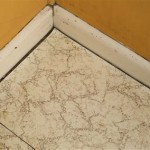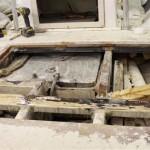Flooring Options Over Ceramic Tile
Ceramic tile, a common flooring material, is known for its durability, water resistance, and aesthetic versatility. However, over time, homeowners may find ceramic tile outdated, damaged, or simply no longer suitable for their evolving needs and design preferences. Replacing ceramic tile can be a costly and time-consuming endeavor, involving demolition, subfloor preparation, and new installation. Therefore, exploring flooring options that can be installed directly over existing ceramic tile presents a practical and cost-effective alternative. This article examines various flooring materials suitable for installation over ceramic tile, considering factors such as installation requirements, cost-effectiveness, and aesthetic appeal.
When considering installing new flooring over existing ceramic tile, several factors must be taken into account. The existing tile surface must be structurally sound, level, and clean. Any loose or damaged tiles should be repaired or replaced to provide a stable base for the new flooring. Uneven surfaces can lead to issues with the new flooring, such as cracking, instability, or uneven wear. The overall height of the new flooring, including any underlayment, should also be considered to ensure it does not create tripping hazards or interfere with doorways or appliances. A moisture barrier is often recommended to prevent moisture migration from the underlying tile to the new flooring material.
Considerations Before Installation
Before embarking on any flooring installation project over ceramic tile, it is crucial to thoroughly assess the existing conditions and plan accordingly. The most important aspect is ensuring the existing tile is firmly adhered to the subfloor. Loose tiles will need to be re-secured or removed and the area patched to create a level surface. Grout lines can also pose a challenge, as they can create an uneven surface that telegraphs through the new flooring material. Filling in grout lines with a leveling compound is often necessary to achieve a smooth, uniform surface. It’s also important to consider the added height the new flooring will create. This can affect door clearances, transitions to other rooms, and the operation of appliances. Measuring door clearances and considering the thickness of the chosen flooring material is crucial to avoid having to modify doors or other fixtures.
Moisture is a key consideration, especially in areas prone to dampness or humidity. While ceramic tile itself is water-resistant, the subfloor underneath may not be. Installing a moisture barrier is highly recommended to prevent moisture from migrating through the tile and damaging the new flooring. This is particularly important for flooring materials like laminate or engineered wood, which are susceptible to moisture damage. Finally, consult with a flooring professional is always advisable. A professional can assess the existing conditions, recommend the appropriate flooring material and installation method, and ensure the project is completed successfully.
The chosen flooring material should also be selected based on its suitability for the specific room and anticipated usage. High-traffic areas may require more durable and scratch-resistant flooring options. Areas prone to moisture, such as bathrooms and kitchens, may benefit from waterproof or water-resistant materials. The desired aesthetic should also be considered, as some flooring materials offer a wider range of styles, colors, and textures than others. Compatibility with the existing décor and personal preferences is essential for achieving a satisfying and visually appealing result.
Laminate Flooring
Laminate flooring is a popular choice for installation over ceramic tile due to its affordability, ease of installation, and wide range of styles. Laminate flooring consists of a multi-layer synthetic material designed to mimic the look of hardwood, stone, or tile. It features a durable wear layer that protects against scratches, stains, and fading. Many laminate flooring products utilize a click-lock installation system, which allows for easy, floating installation over existing tile. This eliminates the need for adhesives or nails, making it a convenient option for DIY projects. Before installing laminate flooring over ceramic tile, it is essential to ensure the tile surface is clean, level, and free of any loose or damaged tiles. A thin foam underlayment is typically recommended to provide cushioning, reduce noise transmission, and protect against moisture. The underlayment also helps to create a smoother surface over the grout lines of the ceramic tile.
Laminate flooring offers a variety of benefits. It is relatively inexpensive compared to hardwood or stone flooring. It is also easy to clean and maintain, requiring only regular sweeping and occasional damp mopping. The durable wear layer makes it resistant to scratches, stains, and fading, making it suitable for high-traffic areas. The click-lock installation system simplifies the installation process, making it a feasible DIY project for many homeowners. However, laminate flooring is not waterproof and can be damaged by excessive moisture. It is generally not recommended for installation in bathrooms or other areas prone to standing water. Additionally, laminate flooring can sound hollow underfoot, especially if installed directly over hard surfaces like ceramic tile. Using a quality underlayment can help to mitigate this issue.
When installing laminate flooring over ceramic tile, it's critical to thoroughly clean the existing tile to remove any dirt, grime, or residues. Leveling any significant imperfections or damaged tiles is essential for a smooth, even surface. An underlayment, typically made of foam or cork, serves as a crucial buffer between the tile and the laminate flooring. This underlayment helps cushion the floor, reduce noise transmission, and provide a moisture barrier. When installing the laminate planks, be sure to follow the manufacturer's instructions carefully. Maintaining consistent expansion gaps around the perimeter of the room is crucial to accommodate seasonal changes in temperature and humidity. These gaps prevent the flooring from buckling or warping. Consider using transition strips where the laminate flooring meets other types of flooring or doorways to create a seamless and professional look.
Luxury Vinyl Plank (LVP) and Tile (LVT)
Luxury vinyl plank (LVP) and luxury vinyl tile (LVT) are increasingly popular flooring options known for their durability, water resistance, and realistic appearance. LVP and LVT are constructed from multiple layers of synthetic materials, including a wear layer, a printed design layer, and a backing layer. They are available in a wide range of styles that mimic the look of hardwood, stone, and ceramic tile. LVP and LVT can be installed over existing ceramic tile using a variety of methods, including glue-down, click-lock, and loose-lay installation. Glue-down installation requires applying adhesive to the tile surface and adhering the LVP or LVT to the adhesive. Click-lock installation involves interlocking the planks or tiles together, creating a floating floor. Loose-lay installation utilizes the weight and friction of the material to hold it in place. The method chosen will depend on the specific product and the condition of the existing tile floor.
LVP and LVT offer numerous advantages. They are highly water-resistant, making them suitable for installation in bathrooms, kitchens, and other areas prone to moisture. The durable wear layer resists scratches, stains, and fading, making them ideal for high-traffic areas. LVP and LVT are also relatively soft and comfortable underfoot compared to ceramic tile, which can be beneficial for individuals with joint pain or other mobility issues. They are also easy to clean and maintain, requiring only regular sweeping and damp mopping. While LVP and LVT are more expensive than laminate flooring, they offer superior water resistance and durability.
Prior to installing LVP or LVT, it is important to thoroughly clean the existing ceramic tile floor. Employ a degreasing cleaner to remove any residues or built-up grime. For glue-down installations, filling grout lines with a leveling compound creates a smooth surface for optimal adhesion. Carefully follow the manufacturer's recommendations for adhesive type and application. For click-lock installations, inspect each plank for any imperfections before installation and ensure a proper, secure fit between planks. When cutting planks to fit around obstacles or along walls, use a sharp utility knife or a vinyl plank cutter for clean, precise cuts. Maintain expansion gaps around the perimeter of the room to accommodate seasonal movement. Consider using transition strips where the LVP or LVT meets other types of flooring or doorways.
Engineered Hardwood
Engineered hardwood flooring provides the aesthetic appeal of solid hardwood with enhanced stability and versatility. It consists of a thin layer of real hardwood veneer bonded to a core of plywood or high-density fiberboard (HDF). This construction makes engineered hardwood less susceptible to expansion and contraction due to changes in temperature and humidity, compared to solid hardwood. Engineered hardwood can be installed over existing ceramic tile using a variety of methods, including glue-down and floating installation. Glue-down installation involves applying adhesive to the tile surface and adhering the engineered hardwood planks to the adhesive. Floating installation utilizes a click-lock system, where the planks interlock to create a floating floor. A moisture barrier is typically recommended to protect the engineered hardwood from moisture migration from the underlying tile.
Engineered hardwood offers several benefits. It provides the natural beauty and warmth of solid hardwood at a lower cost. It is more dimensionally stable than solid hardwood, making it suitable for use in areas with fluctuating humidity levels. It can be installed over a variety of subfloors, including ceramic tile. Engineered hardwood flooring is also relatively easy to clean and maintain, requiring only regular sweeping and occasional damp mopping with a cleaner specifically designed for hardwood floors. However, engineered hardwood is more susceptible to scratches and dents than some other flooring options. It is also not as water-resistant as LVP or LVT, and should not be installed in areas prone to standing water.
When installing engineered hardwood over ceramic tile, ensure the tile surface is clean, level, and free of any loose or damaged tiles. Addressing any surface imperfections ensures a smooth and stable base for the engineered hardwood. A moisture barrier, typically a polyethylene film, is crucial to protect the wood from moisture migration. For glue-down installations, carefully follow the adhesive manufacturer's instructions for application rates and drying times. Use a notched trowel to apply the adhesive evenly across the tile surface. When installing the engineered hardwood planks, stagger the seams to create a more visually appealing and structurally sound floor. Maintain consistent expansion gaps around the perimeter of the room to allow for seasonal movement. These gaps prevent the flooring from buckling or warping. Utilize transition strips where the engineered hardwood meets other flooring types to create a seamless and professional appearance.

How To Lay Vinyl Flooring Sheet Over Tiles

4 Tile To Carpet Transition Options For A Stunning Floor

The 8 Best Tile Flooring Options In 2024 Upgrade Your Space Inc

Best Bathroom Flooring Options
:max_bytes(150000):strip_icc()/inexpensive-kitchen-flooring-ideas-1315016-11-4c3d98a4d3464d48a6d3ed024d485afc.jpeg?strip=all)
4 Inexpensive Options For Kitchen Flooring

Balcony Flooring Options Porcelain Pavers And Interlocking Deck Tiles

What Are The Best Flooring Options For A Concrete Substrate And Design

2024 Bathroom Flooring Trends 20 Updated Styles Inc

Kitchen Floor Ideas Tiling Flooring Vinyl

Best Kitchen Flooring Floor Ideas For Your Home
Related Posts








